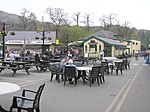Hebron railway station

Hebron railway station is an intermediate passing place and former halt on the Snowdon Mountain Railway, located near a long-standing chapel on the lower slopes of Snowdon south of Llanberis, Gwynedd, Wales. It was named after a Calvinistic Methodist chapel that stood nearby, first built in 1797, which now lies in ruins. It was originally hoped that agricultural traffic could be carried to and from this station. The line starts in the valley bottom at Llanberis at an altitude of 353 ft (108 m), Hebron station stands at 1,069 ft (326 m).The summit station stands at 3,493 feet (1,065 m), 68 feet (21 metres) below the summit of the mountain. The station opened with the railway on 6 April 1896, but both closed the same day following an accident. They reopened on 9 April 1897, without mishap and have operated since except during wartime. The station has one platform.
Excerpt from the Wikipedia article Hebron railway station (License: CC BY-SA 3.0, Authors, Images).Hebron railway station
Llanberis Path,
Geographical coordinates (GPS) Address External links Nearby Places Show on map
Geographical coordinates (GPS)
| Latitude | Longitude |
|---|---|
| N 53.1045 ° | E -4.1179 ° |
Address
Hebron
Llanberis Path
LL55 4UW , Llanberis
Wales, United Kingdom
Open on Google Maps










